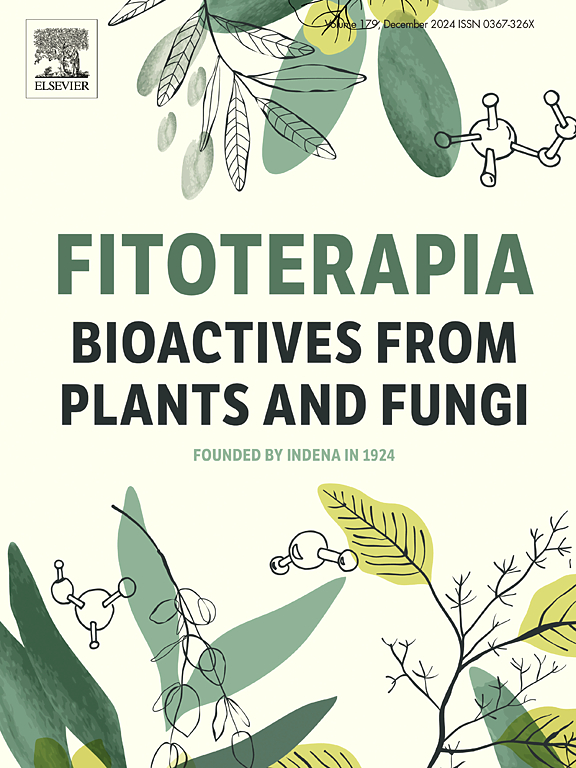The key active ingredients identification and pharmacological mechanism investigation of extract of ethyl acetate from Er Miao San aganist rheumatoid arthritis
IF 2.5
3区 医学
Q3 CHEMISTRY, MEDICINAL
引用次数: 0
Abstract
Background
Er Miao San (EMS) is a basic formula for clearing heat and drying dampness in traditional Chinese medicine (TCM), which is mainly used in the treatment of rheumatoid arthritis (RA). Previous studies have found that the ethyl acetate extract of EMS (EMS-EA) has the best anti-inflammatory effect, but its specific pharmacological material basis is still unclear.
Purpose
The aim of the study was to investigate the active components of the EMS-EA against RA and its mechanism of action using a combination of serum pharmacochemistry and network pharmacology.
Methods
The anti-RA efficacy of EMS-EA was evaluated by establishing a rat model of adjuvant arthritis (AA). The chemical constituents of the EMS-EA and the blood components in the serum of rats after the administration of EMS-EA were detected by the ultra-high liquid chromatography-quadrupole Extractive Orbitrap Mass spectrometry (UPLC-QE-Orbitrap-MS). Network pharmacological analysis was utilized to predict the potential mechanism of action of key blood-entry components against RA, molecular docking, molecular dynamics simulations and in vitro experiments were performed to preliminarily validate the results of network drug prediction. The anti-proliferative activity and pro-apoptotic ability of the key blood-entry components against TNF-α (10 ng/mL)-induced inflammatory injury model of MH7A were detected by MTT assay and TUNEL staining, the levels of IL-6 and IL-1β in the supernatant of the cells were detected by ELISA, and pathway proteins by WB assay.
Results
Compared with the model group, EMS-EA treatment significantly attenuated the ankle joint injury condition in AA rats, reduced foot volume, arthritis index, organ index and serum levels of TNF-α, IL-6 and IL-1β in rats, and alleviated the pathologies such as formation of vascular opacities and synovial hyperplasia of knee joints to different degrees. In positive and negative ion mode, 51 compounds including 19 alkaloids, 8 terpenoids, Subsequently, berberine (BER) and atractylenolide I (AT-I) were detected in the serum collected from rats after EMS-EA administration. Phellodendrine (PHE) found in rat abdominal aorta serum. Network pharmacology,molecular docking and molecular dynamics simulations results revealed that BER、AT-I and PHE may exert anti-RA effects by modulating the MAPK signaling pathway, whose core targets are mainly CASP3, MAPK1 and MAPK8. Finally, we performed in vitro experiments to investigate the anti-RA activity of the three blood entry components mentioned above. The results showed that all three compounds were able to significantly reduce the TNF-α-induced proliferation level of MH7A cells and increase their apoptotic ability, while inhibiting the release of IL-1β and IL-6. WB experiments showed that all three compounds significantly elevated the level of Cleaved-caspase 3 in TNF-α-induced MH7A cells and down-regulated the phosphorylation levels of JNK and ERK.
Conclusion
EMS-EA has excellent therapeutic effects on AA rats, and its chemical components are mainly alkaloids, organic acids and terpenoids. Among them, BER、AT-I and PHE may be its direct acting substances in vivo, and the mechanism of action may be related to the inhibition of MAPK signaling pathway.

二妙散乙酸乙酯提取物抗类风湿性关节炎关键活性成分鉴定及药理机制研究
苗散(EMS)是中医清热燥湿的基本方剂,主要用于治疗类风湿性关节炎(RA)。以往的研究发现,EMS的乙酸乙酯提取物(EMS- ea)的抗炎效果最好,但其具体的药理物质基础尚不清楚。目的采用血清药物化学和网络药理学相结合的方法,研究EMS-EA抗RA的有效成分及其作用机制。方法通过建立大鼠佐剂性关节炎(AA)模型,评价EMS-EA抗ra的疗效。采用超高液相色谱-四极杆萃取轨道阱质谱法(UPLC-QE-Orbitrap-MS)检测EMS-EA的化学成分和给药后大鼠血清中的血液成分。利用网络药理分析预测关键入血成分对RA的潜在作用机制,进行分子对接、分子动力学模拟和体外实验,初步验证网络药物预测结果。MTT法和TUNEL染色检测关键入血成分对TNF-α (10 ng/mL)诱导的MH7A炎症损伤模型的抗增殖活性和促凋亡能力,ELISA法检测细胞上清中IL-6、IL-1β水平,WB法检测通路蛋白水平。结果与模型组比较,EMS-EA治疗可明显减轻AA大鼠踝关节损伤情况,降低大鼠足体积、关节炎指数、脏器指数及血清TNF-α、IL-6、IL-1β水平,不同程度减轻膝关节血管混浊形成、滑膜增生等病变。在正离子和负离子模式下,在EMS-EA给药后的大鼠血清中检测到51种化合物,包括19种生物碱,8种萜类化合物,随后检测到小檗碱(BER)和苍术烯内酯I (AT-I)。在大鼠腹主动脉血清中发现黄柏碱。网络药理学、分子对接和分子动力学模拟结果显示,BER、AT-I和PHE可能通过调节MAPK信号通路发挥抗ra作用,其核心靶点主要是CASP3、MAPK1和MAPK8。最后,我们进行了体外实验来研究上述三种血液进入成分的抗ra活性。结果表明,三种化合物均能显著降低TNF-α-诱导的MH7A细胞的增殖水平,提高其凋亡能力,同时抑制IL-1β和IL-6的释放。WB实验显示,这三种化合物均能显著提高TNF-α-诱导的MH7A细胞中Cleaved-caspase 3的水平,下调JNK和ERK的磷酸化水平。结论ems - ea对AA大鼠具有良好的治疗作用,其化学成分主要为生物碱、有机酸和萜类。其中,BER、AT-I和PHE可能是其在体内的直接作用物质,其作用机制可能与抑制MAPK信号通路有关。
本文章由计算机程序翻译,如有差异,请以英文原文为准。
求助全文
约1分钟内获得全文
求助全文
来源期刊

Fitoterapia
医学-药学
CiteScore
5.80
自引率
2.90%
发文量
198
审稿时长
1.5 months
期刊介绍:
Fitoterapia is a Journal dedicated to medicinal plants and to bioactive natural products of plant origin. It publishes original contributions in seven major areas:
1. Characterization of active ingredients of medicinal plants
2. Development of standardization method for bioactive plant extracts and natural products
3. Identification of bioactivity in plant extracts
4. Identification of targets and mechanism of activity of plant extracts
5. Production and genomic characterization of medicinal plants biomass
6. Chemistry and biochemistry of bioactive natural products of plant origin
7. Critical reviews of the historical, clinical and legal status of medicinal plants, and accounts on topical issues.
 求助内容:
求助内容: 应助结果提醒方式:
应助结果提醒方式:


